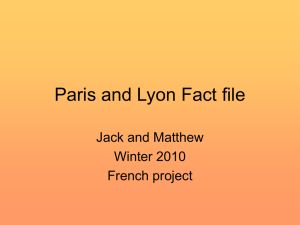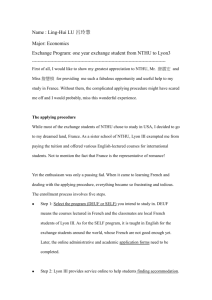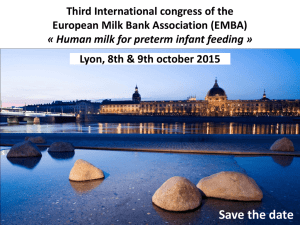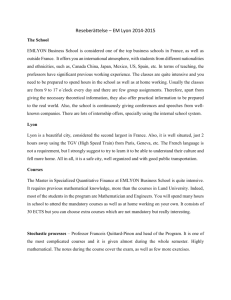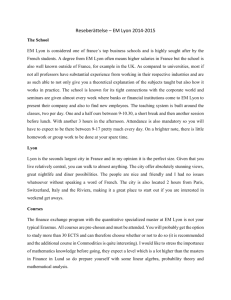Cuisine Overview - Grant Klover's Portfolio
advertisement
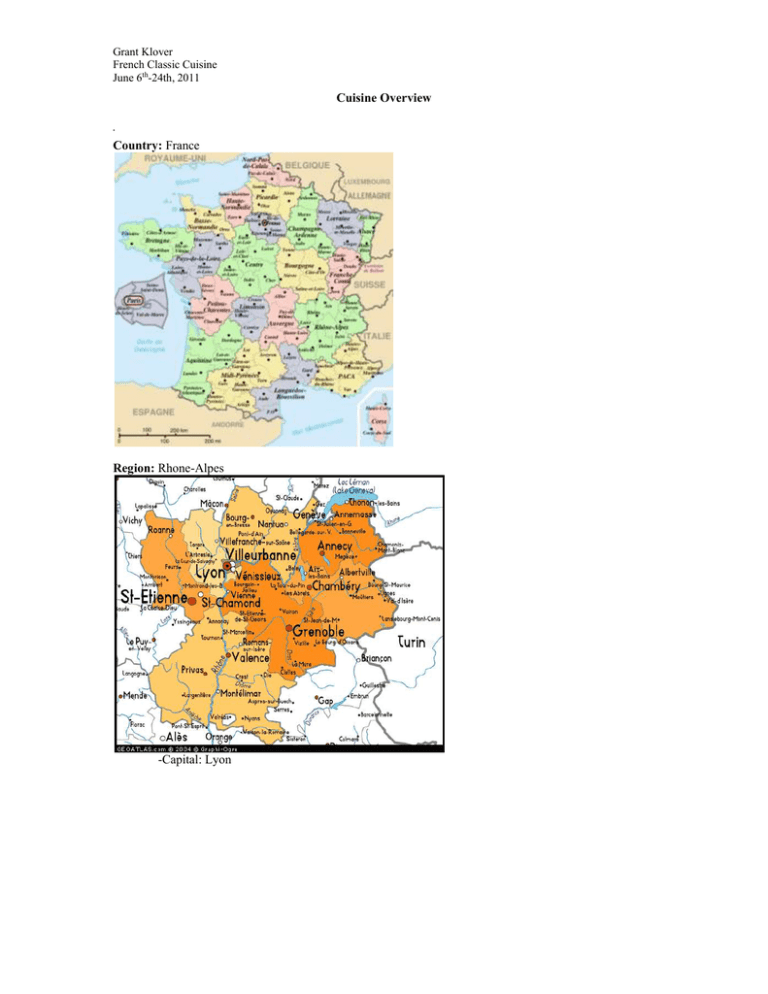
Grant Klover French Classic Cuisine June 6th-24th, 2011 Cuisine Overview . Country: France Region: Rhone-Alpes -Capital: Lyon Grant Klover French Classic Cuisine June 6th-24th, 2011 Panorama of the inner city of Lyon, taken from the basilica of Notre-Dame de Fourvière. Historical/Cultural influences: Lyon France is considered, and has been dubbed, the capital of gastronomy by the famous food writer Maurice Edmond Saillard. And for good reason. Lyon as a region is within easy reach of the celebrated poultry of Bresse, the superb meat of Charolais cattle, the outstanding fish of the Dombes, game and fungi from the nearby forest, and fine cheeses from the hills of the Lyonnais and Beaujolais, as well as the exquisite fruit and young vegetables of the Rhone valley. More than just the food aspects of the Lyon and Rhone regions are the wines from the areas of Beaujolais, Cote-Rotie and Hermitage. With all of the lush history that is present in many of the areas around France, where to begin the adventure in the Lyon region is a real challenge. But as with many places in history the history of the food comes about because of war. After the French Revolution, and during the Second Empire, the pleasures of the table were held in high esteem in the houses of the bourgeoisie and the textile magnates and people began to develop their taste. Well off wealthy families had access to the finer ingredients and could also afford to hire the chefs to do them justice. However, with the onset of the Franco-Prussian War, and then moving on to World War 1, many chefs and cooks lost their Jobs in the times of crisis that followed. Some of the bold ones opened their own restaurants and prepared the same foods that they had set before previous employers. These brave chefs became known as les meres, and kept with using their familiar ingredients and what were often no more than a handful of tried and trusted recipes. Unlike before, however, the clientele were les canuts- or blue collared workers. These blue collared workers found meres that would cook for them with the same dedication and passion but would just use less costly ingredients and, more important than anything, charge less. They would also use the less desired cuts of meat that the finer folk disdained. Cuts such as the entrails, and the tougher undercuts of beef and veal; above all else, they would use a lot of pork. Fish such as carp and eels combined with butter, cream, and generous amounts of wine, was the start of the bistros bouchons et porte-pots for which the region of Lyon became known for. The bistros would be open from six and nine in the morning when the workers on the night shift would need to eat. The main choice of cuisines would be boiled or chitterling sausages, smoked bacon, braised calf’s trotters or stuffed pig’s trotters. Sausage from Lyon is also one of the greatest centers of the butcher’s art, with respects being paid to the less glamorous parts of the animal such as the head, trotters and chitterlings. Anyone who could turn the entrails into tasty sausages must be able to create great works of art from the more noble ingredients. Most of the sausage was made from mature pigs using, as I have said before, the less desired cuts of meat but also cuts like the hams and shoulders. The most common seasonings found in the sausages were black pepper and sea salt. During the 16th century the Italian gastronomy crossed the banks of the Rhone and Grant Klover French Classic Cuisine June 6th-24th, 2011 Saone rivers and have had an impact on the cuisine in Lyon regions ever since. Things like pistachios and, finally, chopped truffles started to find their way in to the sausages. Along with sausage Lyon is also known for its chocolate. Around 1900 Lyon established itself as the capital of the chocolatiers, or the chocolate makers. Anyone wishing to devote themselves to the art of mixing their own chocolate would come here and learn how to mix their own cocoa beans and cocoa butter. In today’s time there is only one company left in Lyon that makes their own chocolate. The chocolatiers at Bernachon now put together mixtures of beans, which are balanced by type and then ground to make the Lyon regions widely sought after chocolates. Much contention has been had over the Beaujolais region and where it belongs. Make no mistake about it though; the region has never belonged to Burgundy. No other French red wine is as famous as Beaujolais. Just as the workers in Lyon fortified themselves with the substantial breakfast, the vine growing Beaujolais region developed its own form of machon that could match the version being served in Lyon. Most of the time the machons would be a basket full of dried sausages, smoked bacon, good farm baked bread, a bottle of Beaujolais and a few cheeses from Monts du Beaujolais. These little cheeses, made by the farmers on their farms from goat’s milk and or cow’s milk, are specialties which are so prized by the Beaujolais and Lyonnais that you hardly ever find them outside of the region. Moving to the right bank of the Rhone that faces south there is one of the oldest wine producing areas of France. It is believed that vines were planted here as far back as the 4th century BCE. At all events the Romans, arrived around 100 BCE and, recognizing the regions potential, planted vines. Another very interesting feature of the Rhone valley is that of Chartreuse, where French monks made different elixirs. Only three of the Carthusian monks know the recipe, with ingredients derived from a total of 130 plants, and the proportions in which they are mixed. To produce the liqueurs from these elixirs honey must be added, notwithstanding the secrets of distillation that was brought back from the Orient by Arnau de Villanova. At this time whatever came from the Orient was very much the height of fashion. Oranges for instance, became very popular, as did the liqueur Dutch Curacao, made from bitter oranges. With wine being so abundant in both Lyon and the Rhone it is no wonder that a multitude of fruit is grown and farmed all throughout the region. The Rhone valley is an extensive orchard, which stretches from Lyon in the north all the way to the Mediterranean in the south. Vaucluse and Bouches du Rhone, bordering alongside the Rhone, are the biggest suppliers of apples and pears, though Drome beats all other regions when it comes to apricots and peaches. Walnuts are grown in Isere, sweet chestnuts from Ardeche, cherries and still more apples from Savoy. And, finally, the best raspberries come from the Alpine slopes of Haute Savoie. Apples followed closely by peaches are the most popular fruit in French households. All sorts of fruit is grown in the Rhone “fruit bowl”, strawberries and melons, as well as the Far East kiwi, which is originally from New Zealand, can be found in the Rhone valley. In the North, or far to the north of Lyon, the Dombes plateau is where the region finds it’s abundance of fish breeding ponds. The plateau owes its origins to the last ice age, and can boast breeding pools dating back to the 12th century, and which today covers an area of 24,700 acres. With catches amounting to 2200 tons per year the catch of fish from the breeding pools is significant. As a pool’s cycle comes to an end and needs to be drained it is sown with grain and maize for one year to rebuild the soil around the pool. Along with fish, another of the great attractions of the area is the poultry from Bresse. The Bresse fowl walk around on blue feet, sporting a dazzlingly white plumage and fiery red crest. The Bresse region stretches from the foothills of Jura in the east and all the way to the Saone in the west. In 1957 the French parliament decided that the Bresse fowl was the only kind allowed to honored by an Appellation d`Origine Controlee which until then had been restricted to wines, cheese, and a few others delicacies. What makes the poultry so prized is the scientific precision in which it is maintained, and fed a fodder of corn soaked in milk from the local dairy farms. It is also raised almost entirely free ranged but caged for the last few weeks of its life to put on a layer of fat that makes it so flavorful. Religion (s): France is a secular country. According to law, the church and the state are separated. There are, however, 5 major religions in France: Catholicism which is the traditional religion of France, Protestantism, Islam, Judaism and Buddhism. The French government provides complete freedom of religion as a constitutional right. "Religion in France - Travel Information and Travel Guide for France." GoAbroad.com Travel Information and Travel Guides. Web. 09 June 2011. <http://www.goabroad.info/France.html?gID=3267>. Grant Klover French Classic Cuisine June 6th-24th, 2011 Climate and geographical influences: Rhône-Alpes is located in the east of France. To the north are the French regions of Bourgogne (Burgundy) and Franche-Comté, to the west it borders the region Auvergne, to the south it borders LanguedocRoussillon and Provence-Alpes-Côte d'Azur. The east of the region contains the westernmost part of the Alps and borders Switzerland and Italy. The highest peak is Mont Blanc, on the French-Italian border. The central part of the region comprises the river valleys of the Rhône and the Saône. The confluence of these two rivers is at Lyon. The western part of the region contains the start of the Massif Central mountain range. The region also borders or contains major lakes such as Lake Geneva (Lac Léman) and Lake Annecy. The Ardèche River flows through the southwest portion of the region, where it has carved the deepest gorge in Europe. Climate Lyon is classed as borderline Oceanic and Humid Subtropical (Koppen Cfb/Cfa). Winters are cooler than much of the rest of France due to its more inland position, but generally not cold, averaging 3.2 °C (37.8 °F) in January. Summers are very warm, averaging 21.3 °C (70.3 °F) in July. Precipitation is adequate yearround, at an average of 840 millimeters (33.1 in), but the winter months are the driest. Grant Klover French Classic Cuisine June 6th-24th, 2011 Staple grains and carbohydrates and representative dishes: Crozets: little squares of wheat pasta (buckwheat also available) usually served as a dish in its own right mixed with lardons, crème fraiche and Beaufort cheese. Potatoes: as well as being the main ingredient for tartiflette/pela, potatoes are often served as gratin savoyarde (simply a potato gratin). Beignets de pomme de terre are a type of rösti but formed into sausage-shapes and sometimes served with starters including salads. Polente: the local spelling for polenta – deemed local since the Duchy of Savoie included much of north-west Italy including Turin. It is served as an accompaniment to pork or rabbit stews or sausages, and it may well be finished off with Beaufort cheese and crème fraiche. Chickpeas Chestnuts Until the introduction of the potato, whole forest-dwelling communities which had scarce access to wheat flour relied on chestnuts as their main source of carbohydrates. A tree typical to the Ardèche landscape, the chestnut tree holds within itself the living memory of the inhabitants. Protein sources and representative dishes: Guinea Fowl of the Drôme Goat Beef from Charolais Lamb Game: Hare, thrushes Pork (most notably different types of sausages) Poultry from Bresse Whitefish Char Perch Grant Klover French Classic Cuisine June 6th-24th, 2011 Trout Pike Carp 1. Geneva Pork Fricassee 2. Braised Bresse Chicken with Preserved Lemon and Crayfish 3. Char with Lemon Cooking fat: Pork Fat Butter (beef Charolais) Olive Oil (Nyons) Vegetables and representative vegetable dishes: Blue Solaize leeks Potatoes Chard Ampuis Garlic from Drome Kale Onion Tournon Mache Chickpeas Grant Klover French Classic Cuisine June 6th-24th, 2011 Chili Cardoon 1. Cardoon Gratin 2. Farçon (A farçon is made of potatoes (above all), puréed or grated and combined with eggs, milk, and, sometimes, bacon. Fresh or dried fruit, cabbage, and assorted herbs are often added. The ingredients may be cooked in a bain-marie or baked in the oven. It may be packed into a terrine or casserole dish, or cooked in a besace—a cloth sack soaked in bouillon) Fruits and representative dishes: All sorts of fruit is grown in the Rhone “fruit bowl” Apples Pears Apricots Peaches. Cherries Strawberries Melons Grapes (many different types are present please see the beverages section for more information) Olives Grant Klover French Classic Cuisine June 6th-24th, 2011 Herbs: 1. Rissole (A pastry stuffed with anything from meat or fish, but mostly eatten for dessert and stuffed with Pears, Aprocots, or other fruits) 2. Apple Tartin Sage Parsley Thyme Savory Fennel Spices/flavorings (to include primary sweeteners): Chamonix honey Anise Sugar Acacia flower Cacao(chocolate) Flavorings in desserts Alpine sweets include gâteau de Savoie, made with potato flour Grenoble’s walnut cake, sometimes doused with Chartreuse liqueur. Bugnes (lemon fritters) Almond-filled puff pastries. Grant Klover French Classic Cuisine June 6th-24th, 2011 Marrons glacés (candied sweet chestnuts) used in cakes or simply pureed to make the most delicious creamy filling for cakes and pastries. Preserved foods: Large varieties of cured meats and sausages from all over the region Cheese: o Tomme de Savoie (a mild-flavored, semi-soft cheese) and Beaufort (the gruyère of Savoie), Chevrotin des Alpes, Reblochon and Dauphinois are the specialties of the mountains. o The Vacherin de Chambéry is an extra-creamy cheese that is eaten with a spoon. o North of Lyon, Bleu de Bresse and Bleu de Gex are creamy blue-veined cheeses and Chevretons du Beaujolais is made with goat-milk. Beverages: Grant Klover French Classic Cuisine June 6th-24th, 2011 The region has three main vineyards areas: the Beaujolais, the wines of the Rhone Valley, and the Savoy wine region White grapes in the area include but are not limited to: Roussanne, Chardonnay, Chasselas, and Highness. Red grapes of the Region include but are not limited to: Pinot Noir, Gamay, Syrah, and Mourvedre. Vermouth Chambery Kario Kylon (brown liquor flavored with fresh walnuts) Chartreuse Alps wormwood Harquebus Hermitage Specialized cookware or cooking methods: With the prevalence of so many different types of au gratin recipes from the region you could say that the au gratin dish has become a specialized cookware Grant Klover French Classic Cuisine June 6th-24th, 2011 It is also a note that because of the many different types of cured sausages in the region that the drying racks and meat grinders have become specialized for each and every shop. Ingredient origins: (Ingredients used in the region’s cuisine that you mentioned in the Cuisine Overview) Asian ingredients that have had an impact on the region’s cuisine (3) Peaches (Peaches were probably the first fruit crop domesticated in China about 4000 years ago. "Peaches." Mark Rieger's Fruit Crop Home Page. Web. 09 June 2011. <http://www.fruit-crops.com/peach.html>.) Garlic The Chartreuse brewing techniques (Although the Arabs and Chinese are known to have used primitive distillation methods, a Catalan French doctor, Arnaud de Villeneuve (Arnau de Vilanova), and Raymond Lully (Ramon Lull) in the late 13th century are credited with being the first distillers of eau-de-vie, or brandy, which, when sweetened, became the first liqueur) Monocle, T. Von. "Liqueurs." HubPages. Web. 09 June 2011. <http://hubpages.com/hub/liqueurs>.) American/New World ingredients that have had an impact on the region’s cuisine (3) Cacao (chocolate) Potatoes Strawberries and Raspberries (both of which are featured in Rissole style desserts and in raspberrie’s case used in truffle chocolates) Europe / Middle East World ingredients that have had an impact on the region’s cuisine (3) Olives Pork (In the foothills of the Taurus Mountains, Hallan Cemi in southeastern Turkey. There, the pig was apparently kept as early as 8000 B.C. "The Cambridge World History of Food - Hogs." Cambridge University Press. Web. 09 June 2011. <http://www.cambridge.org/us/books/kiple/hogs.htm>.) Honey (From Egypt as early as 5500bc) Chestnuts
